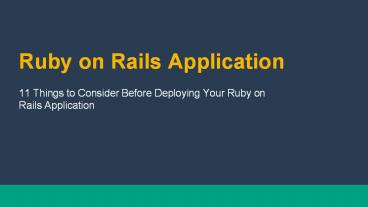Ruby on Rails Application - PowerPoint PPT Presentation
Title:
Ruby on Rails Application
Description:
At VinSol, we have been developing and deploying Rails applications for more than four years. During this period, we have identified some best practices that we prefer to follow while deploying rails application to production server. – PowerPoint PPT presentation
Number of Views:44
Title: Ruby on Rails Application
1
Ruby on Rails Application
- 11 Things to Consider Before Deploying Your Ruby
on Rails Application
2
Ruby on Rails
- At VinSol, we have been developing and deploying
Rails applications for more than four years.
During this period, we have identified some best
practices that we prefer to follow while
deploying rails application to production server.
3
Below is the checklist of these practices
- 1. Ensure that NS records and MX records are
changed if they need to be changed - Changing nameservers will point the domain to the
hosting server, and changing MX records will
redirect incoming mails to the mail server. As a
very first step, we should make sure that name
servers of the domain are set to be the correct
one. Changing MX record is a must if our
application is parsing incoming mails or we wants
to use other mail services for e-mail exchange,
for example Gmail.
4
2. Ensure some backup mechanism in place for both
data as well as user uploaded content like
images/documents etc.
- Since production data is very critical, we must
setup backup mechanism. It could be some type of
scheduled task that takes periodic backup of all
critical data, Or it could be some type of backup
service provided by hosting company. When we talk
about critical production data, it includes
production DB, content generated by application
users like images, documents, etc.
5
Ensure Database indexes
- We might have done development without having
proper database indexes, but we should avoid
going to production without them. Adding indexes
might slow down insert queries a bit but it
increases the performance of read queries. It
applies when application in production has
percentage of read operations much more than
write operations.
6
Enable your slow query log
- This is specific to MySQL. Enabling slow query
log allows MySQL to log slow running queries to a
file. And this log can be used to find queries
that take a long time to execute and are
therefore candidates for optimization.
7
Ensure exception is in place
- We might want to be notified when something bad
happens to our application. There are several
hosted services available who receive and track
exceptions, for example Hoptoadapp.com,
GetExceptional.com etc Either we can choose one
from these hosted services or we can use
exception notifier plugin.
8
Ensure adding entries for cron/scheduled jobs
- Most of the applications have some
functionality/jobs that need to be run
periodically, for example generating invoices,
sending newsletters etc. In most cases these
jobs are done by a rake task. We should make sure
that we have added such jobs to cron or similar
program.
9
Monitoring Important Processes
- To ensure that our site is up 247 we need to
ensure that all processes that our application
needs are up. There can be many processes like
MySQL, Mongrel, Apache etc.. These processes are
very important as our application directly
depends on them. For example if MySQL process get
killed accidentally, our application would not be
able to connect to MySQL and will start throwing
exceptions. We can choose any of the available
monitoring tools like God, Monit, 247 etc
10
Ensure Confidential Data Filtering
- We would never like to leak/share confidential
information of our application users. We should
make sure that none of the users confidential
data like SSN, Credit card info, password are
being written to log files. We might not have
paid much attention on this while developing the
application.
11
Rotate Log Files
- Once our site is up and running, every single
request write some text in log file. And hence
size of the log file keeps on increasing. Larger
log files can put us in trouble if we get it
beyond certain size. Its difficult to manage
these log files, as larger files need more memory
to open and need more time to download. In one of
the rescue project we did , the log file size was
3GB. - We would recommend having logrotate setup for the
application.
12
Setup Asset Host
- Setting up asset hosts can reduce loading time by
50 or more. We must setup asset hosts for our
application. Once asset hosts are all set, our
static files will be delivered via asset hosts
for example asset1.hostname.com,
asset2.hostname.com
13
Clearing up stale sessions
- We should make sure we should not left any stale
session on the server. If our application is
using DB or file system as session store, we
must add a schedule task to delete stale
sessions. - These are some of the points we have identified
from our past experience and we might be missing
some. Feel free to always add them as comments,
and Ill keep this post updated.
14
Thank you
- See more at - http//vinsol.com/blog/2009/11/16/11
-things-to-consider-before-deploying-your-rails-ap
plication/































